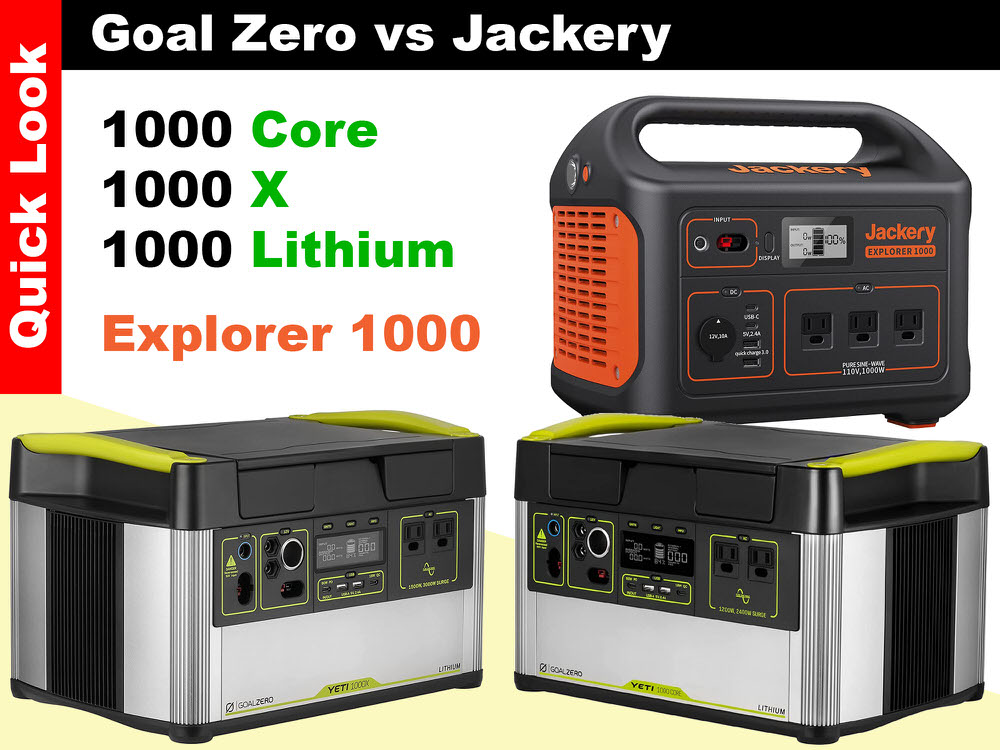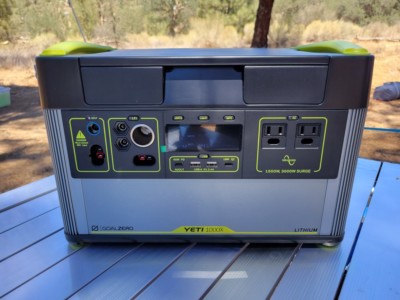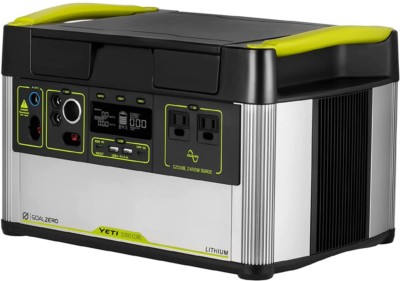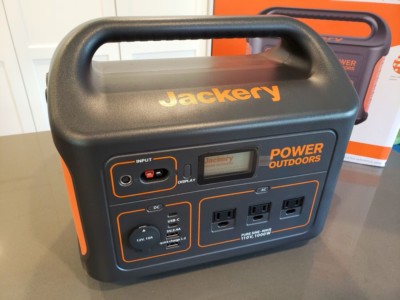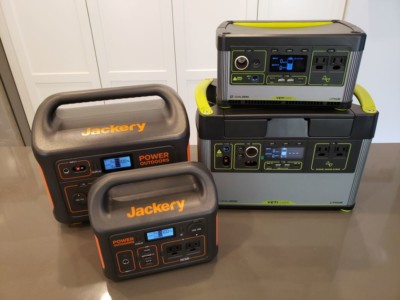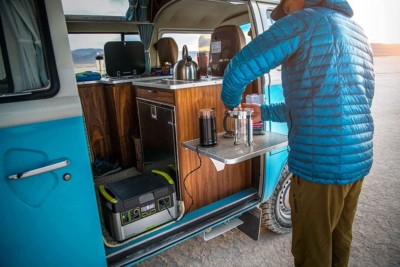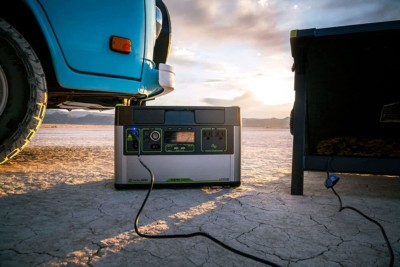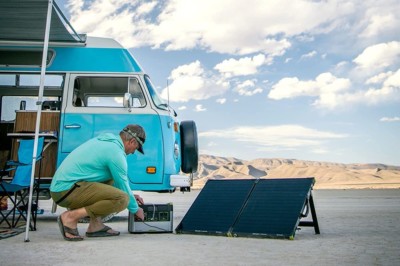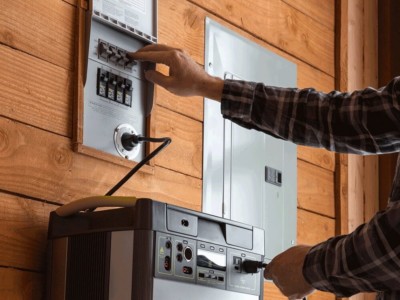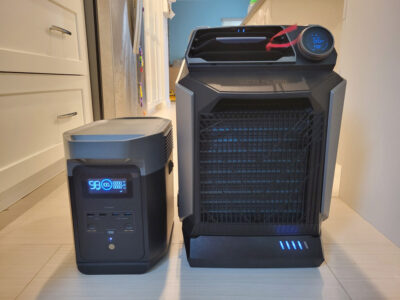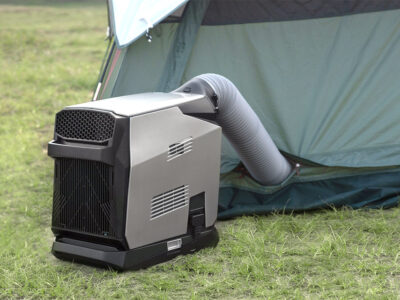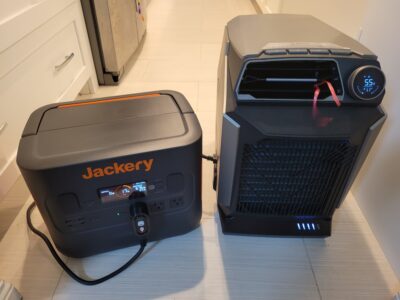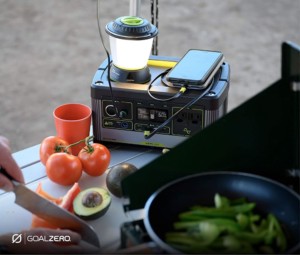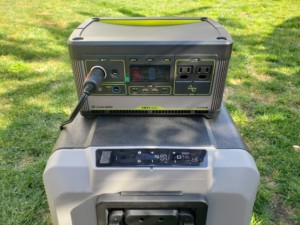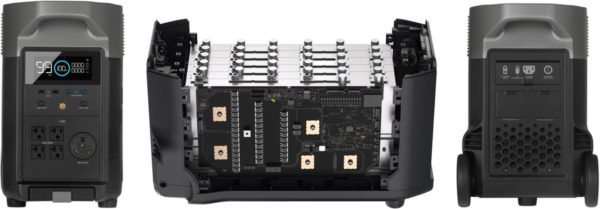Contents
Yeti 1000 Core Announcement
Article updated 7/16/2021 with new details from Goal Zero customer service about launch/retail pricing, Expansion Module support, and Amazon-exclusive distribution.
In the early morning of June 30, 2021, at 5:01am PST, I received a surprise email from Goal Zero announcing that something new was coming. That set me off in a hours-long research to find more information and ultimately shared my findings in this article: Goal Zero Yeti 1000 Core (1000c) Launching July 16, 2021! Turned out, most of my predictions came true.
With the Yeti 1000 Core now available, what are the differences between the Yeti 1000x and the 1000 Core (aka 1000core or 1000c)? Why would Goal Zero launch ANOTHER 1,000 Wh battery just FIVE (5) weeks after the flagship Yeti 1000x became available? I will attempt to analyze the differences between the Yeti 1000x, Yeti 1000 Core, and for good measure, the Jackery Explorer 1000 and Yeti 1000 Lithium.
In A Nutshell
Goal Zero launched the Yeti 1000 Core power station on July 16, 2021, five weeks after the flagship Yeti 1000x was available for purchase. The new model retains the same dimensions and ports as its sibling, but at a reduced price of $999 (with early bird/launch pricing of $899), a slightly smaller AC inverter (1,200W continuous, 2,400W peak), and a lower, maximum charging input of 300W. It also loses support for the Yeti Link expansion module that would have allowed it to be extended with the Yeti Tank expansion batteries or integrated with the Home or Vehicle with the appropriate kits. It is an Amazon-exclusive product in an apparent effort by Goal Zero to counter lower-priced batteries offered by its online-only competitors, like the now outdated Jackery Explorer 1000.
Yeti 1000 Core is a good entry point into higher-capacity power stations from a company known for its safety record, large ecosystem of accessories and expansion modules, quality components, and global market leadership. It looks to be VERY well-positioned against one of my favorites, the Jackery Explorer 1000, with MUCH better features, specifications, and components for the same price, and is nearly the same as the flagship Yeti 1000x for $300 less (or $400 at launch).
When considering whether the Yeti 1000x or Yeti 1000 Core is better, I recommend the Core for most consumers who do not need all the bells and whistles offered by the 1000x, like the expansion options and higher input/output capabilities. The Yeti 1000x would be for those who want to be able to extend its capacity with more batteries, integrate into the home in case of a power outage, or vehicle for those living the nomadic “RV” life. It would also be for those who need the higher AC Inverter output of 1,500W (continuous) or 3,000W (peak) for more demanding power tools or appliances. Both power stations are fully solar-charging capable and have an efficient, integrated MPPT solar charge controller, although the 1000x can be juiced with more powerful solar panels for faster charging at up to 600W (versus the Core’s 300W).
The Yeti 1000 Lithium — an outdated model — comes with the PWM charge controller and can be outfitted with an optional Yeti MPPT module.
You can buy the Yeti 1000 Core only on Amazon, the Yeti 1000x on GoalZero, Amazon, and other retailers, and the Jackery Explorer 1000 on Amazon and Jackery.com. The Yeti 1000 Lithium model is outdated.
Comparison Summary
Here is a summary of differences between the various 1000Wh power stations from Goal Zero, EcoFlow, and Jackery Explorer. The Yeti 1000 Lithium is the oldest of the Yeti series.
| Product | Battery Capacity | AC Inverter (Continuous) | AC Inverter (Surge) | Max Input | MSRP | Expandable | Charge Controller | WiFi, BT | Battery Supplier | Weight | Dimensions (inches) |
|---|---|---|---|---|---|---|---|---|---|---|---|
| EcoFlow Delta 2 | 1,024Wh LiFePO4 | 1,800W | 2,700W | 1,200W | $999 | Yes. Extra Battery 1, 2 | MPPT | Yes | EcoFlow | 27 lbs | 15.7 x 8.3 x 11 |
| EcoFlow Delta 1000 | 1,008Wh NCM | 1,600W | 3,100W | 1,000W | $799 | No | MPPT | No | EcoFlow | 30.9 lbs | 15.7 x 8.3 x 10.6 |
| Jackery Explorer 1000 | 1,002Wh NCM | 1,000W | 2,000W | 200W | $999 | No | MPPT | No | LG or BAK | 22 lbs | 13.1 x 9.2 x 11.1 |
| Jackery Explorer 1000 Pro | 1,002Wh NCM | 1,000W | 2,000W | 800W | $1,099 | No | MPPT | No | LG or BAK | 25.4 lbs | 13.4 x 10.3 x 10.1 |
| Goal Zero Yeti 1000c | 983Wh NCM | 1,200W | 2,400W | 300W | $999 | No | MPPT | No | LG | 31.7 lbs | 15.3 x 10.2 x 9.9 |
| Goal Zero Yeti 1000x | 983Wh NCM | 1,500W | 3,000W | 600W | $1,299 | Yes. Yeti Link | MPPT | No | LG | 31.7 lbs | 15.3 x 10.2 x 9.9 |
| Goal Zero Yeti 1000 Lithium | 1,045Wh NCM | 1,500W | 3,000W | 360W | $1,199 | Yes. Yeti Link, MPPT | PWM | No | LG | 40 lbs | 15.3 x 10.1 x 9.3 |
Comparison Details
Yeti 1000 (X vs Core vs Lithium) vs Jackery Explorer 1000
The Goal Zero Yeti X is the company’s flagship product line. It was difficult to imagine a new product launching five weeks later that would be superior. Indeed, that was not the case as the Yeti 1000 Core was a lower-priced model and in line with the Jackery Explorer 1000. Here are the similarities and differences with a summary provided at the end.
Price
- Goal Zero Yeti 1000x: $1,299 / Yeti 1000c: $999 / Yeti 1000 Lithium: $1,199
- Jackery Explorer 1000: $999
Update 7/16/2021: Customer Service shared that the Yeti 1000 Core’s $899 price currently found on Amazon is its early bird/launch pricing. It will revert to $999 after its promotion period, bringing it in line with the Jackery Explorer 1000.
AC Inverter
An AC Inverter is responsible for converting DC (battery) power into AC — what you commonly see coming out of wall outlets. All four products output Pure Sine Wave for clean power and lower heat generation to protect against damage to connected, sensitive electronics.
- Yeti 1000x / 1000 Lithium: 1,500W continuous / 3,000W peak
- Yeti 1000c: 1,200W continuous / 2,400W peak
- Explorer 1000: 1,000W continuous / 2,000W peak
The Peak rating determines how much power an AC inverter can handle when a connected device is powered on. The Continuous rating applies to devices that are already on/running. For example, a TV may temporarily suck up 700W (peak) when turned on, but only uses 200W (continuous) while in use.
Battery Capacity
How much energy a battery can store is measured in Wh (Watt-hours), and how much power is used or produced in W (Watts). A device’s power usage or a charging source’s output is rated in Watts (Amps x Voltage). See one of my battery power station reviews to learn more about Watts, Watt-hours, Continuous/Running and Peak/Surge outputs, and how to perform various calculations.
- Yeti 1000x / 1000c: 983 Wh
- Yeti 1000 Lithium: 1,045 Wh
- Explorer 1000: 1,002 Wh
Battery Cell Manufacturer
Battery cells made by LG and Sony are among the best in the hobbyist world as are Sanyo/Panasonic and Samsung. During my years of research, I found that use of lower-quality batteries could pose a serious risk to life and property and should become a crucial part in deciding what to buy.
- Yeti 1000x / 1000 Lithium: LG / Lithium-ion
- Yeti 1000 Core: LG / Lithium-ion – Confirmed 7/16/2021 by Customer Service
- Explorer 1000: LG or BAK Battery (both are great) / Lithium-ion
Weight & Dimensions
- Yeti 1000x / 1000c: 15.3″ x 10.2″ x 9.9″ @ 31.7 lbs
- Yeti 1000 Lithium: 15.3″ x 10.1″ x 9.3″ @ 40 lbs
- Explorer 1000: 13.1″ x 9.2″ x 11.1″ @ 22 lbs
Goal Zero’s power stations are generally made with more heavy-duty metals whereas Jackery’s are with hard plastics. The latter material makes products lighter but also is more prone to damage. Be extra careful when handling lithium-ion batteries as a puncture could have harmful consequences.
The Yeti 1000x, 1000 Core, and 1000 Lithium fit the Goal Zero Yeti Carry Case (Large) (Buy at Goal Zero | Amazon) that allows them to be used without taking out of the bag. I loved its design when used with the Yeti 1500x!
Solar Charge Controller
All products, except the Yeti 1000 Lithium, have an integrated MPPT solar charge controller. The MPPT allows for smarter, faster, and more efficient solar charging, but also costs more than PWM. MPPT is best suited for larger power stations. The old Yeti 1000 Lithium uses PWM and can be upgraded with an optional Yeti MPPT module.
Charging Capacity (Input)
Here are the maximum inputs the power stations can be charged with, whether by AC wall adapter, solar, or other means.
- Yeti 1000x: 150W via 8mm / 600W via HPP (APP) / 60W via USB-C PD / 210W via 8mm and USB-C PD simultaneously
- Yeti 1000c: 150W via 8mm / 300W via HPP (APP) / 60W via USB-C PD / 210W via 8mm and USB-C PD simultaneously
- Yeti 1000 Lithium: 120W via 8mm / 360W via HPP (APP)
- Explorer 1000: 200W via 8mm / 200W via APP / 18W via USB-C PD
Tip: The Goal Zero 12V Car Charger can charge both Goal Zeros and Jackery at a whopping 120W instead of the standard 60W!
Input/Output Ports
Here are the input and output ports and their maximum wattages.
Note: Goal Zero renamed its Anderson Powerpole (APP) ports in Nov 2020 to High Power Port (HPP) to avoid trademark infringement with its inventor: Anderson Power Products. This is only a name change as the connector works the same way as before. For the purpose of avoiding confusion, I will interchangeably refer to the port as HPP or APP.
- Yeti 1000x
- Input: (2) 8mm / HPP (APP) / USB-C PD
- Output: (2) AC with 3 prongs / HPP (APP) / 12V Car 180W / (2) 6mm 120W / USB-C PD 60W / (2) USB-A 12W / USB-C 18W QuickCharge
- Expansion Module port for use with Yeti Link, Yeti Tank Expansion Batteries, Home Integration Kit, and Vehicle Integration Kit. Learn more (YouTube): Yeti Link + Tank and Yeti Home Integration Kit
- Yeti 1000c
- Same as Yeti 1000x, except:
- HPP max input is 300W instead of 600W
- Update 7/16/2021: Customer Service stated that the Yeti 1000 Core does NOT support the Expansion modules
- Same as Yeti 1000x, except:
- Yeti 1000 Lithium
- Input: (2) 8mm / HPP (APP)
- Output: (2) AC with 3 prongs / HPP (APP) / 12V Car 120W / (2) 6mm 120W / (4) USB-A 12W
- Expansion Module port for use with Yeti Link, Yeti Tank Expansion Batteries, Home Integration Kit, and Vehicle Integration Kit. Learn more (YouTube): Yeti Link + Tank and Yeti Home Integration Kit
- Explorer 1000
- Input: 8mm / APP
- Output: (3) AC with 3 prongs / 12V Car 120W / (2) USB-C PD 18W / USB-A 12W / USB-A 12W QuickCharge
WiFi/Bluetooth: None of the four products have WiFi or Bluetooth control capability like the Yeti 1500x.
Expansion Capability
- Yeti 1000x / Yeti 1000 Lithium
- Support Yeti Link module for extending battery capacity with Yeti Tanks and integrating into the Home and Vehicle with the appropriate kits. Yeti Link is installed by removing a cover inside the top compartment. The Yeti 1000 Lithium can have a MPPT module added to replace its PWM. This would increase its solar charging efficiency
- Learn more (YouTube): Yeti Link + Tank and Yeti Home Integration Kit
- Yeti 1000c
- Cannot be expanded. Does NOT support Yeti Link module, according to Customer Service on 7/16/2021
- Jackery Explorer 1000
- Cannot be expanded
Availability
- Yeti 1000x: GoalZero.com, Amazon, and other retailers (both online / brick-and-mortar)
- Yeti 1000 Lithium: GoalZero.com, Amazon, and other retailers (both online / brick-and-mortar) – May no longer be in stock as it is an outdated model
- Yeti 1000c: Amazon (only)
- Explorer 1000: Amazon, Jackery.com
Goal Zero Yeti Models
| Product | Battery Capacity | AC Inverter (Continuous) | AC Inverter (Surge) | Max Input | Expandable | Charge Controller | WiFi, BT | Weight | Dimensions (inches) |
|---|---|---|---|---|---|---|---|---|---|
| Yeti 200x | 187Wh NMC | 120W | 200W | 120W | No | MPPT | No | 5 lbs | 7.9 x 5.1 x 5.1 |
| Yeti 500x | 505Wh NMC | 300W | 1,200W | 120W | No | MPPT | No | 12.9 lbs | 7.5 x 11.3 x 5.8 |
| Yeti 1000c | 983Wh NMC | 1,200W | 2,400W | 300W | No | MPPT | No | 31.7 lbs | 15.3 x 10.2 x 9.9 |
| Yeti 1000 Lithium | 1,045Wh NMC | 1,500W | 3,000W | 360W | Yes. Yeti Link, MPPT | PWM | No | 40 lbs | 15.3 x 10.1 x 9.3 |
| Yeti 1000x | 983Wh NMC | 1,500W | 3,000W | 600W | Yes. Yeti Link | MPPT | No | 31.7 lbs | 15.3 x 10.2 x 9.9 |
| Yeti 1500x | 1,516Wh NMC | 2,000W | 3,500W | 600W | Yes. Yeti Link | MPPT | WiFi, BT | 45.6 lbs | 15.3 x 10.2 x 10.4 |
| Yeti 3000x | 3,032Wh NMC | 2,000W | 3,500W | 600W | Yes. Yeti Link | MPPT | WiFi, BT | 69.8 lbs | 15.3 x 10.2 x 13.6 |
| Yeti 6000x | 6,010Wh NMC | 2,000W | 3,500W | 600W | Yes. Yeti Link | MPPT | WiFi, BT | 106 lbs | 15.3 x 10.1 x 17 |
Portable Air Conditioner
The EcoFlow Wave is a portable air conditioner that accepts both AC and DC input. The company, of course, recommends using its own Delta power stations for better efficiency and longer runtime because they can draw directly from DC power. In a pinch, any battery or generator capable of providing the Wave-required input wattage could be used, but keep in mind that AC power loses some energy due to conversion to DC.
Final Thoughts
Goal Zero made a surprise announcement with the Yeti 1000 Core just five weeks after the Yeti 1000x was launched. The new model retains the same dimensions and ports as its flagship sibling, but at a reduced price of $999 (with early bird/launch pricing of $899), a slightly smaller AC inverter, and lower, maximum charging input of 300W. It also loses the Yeti 1000x’s Expansion module support that would have allowed it to be extended with the Yeti Tank Expansion Batteries or integrated with the Home or Vehicle using the appropriate kits.
The new model is an Amazon-exclusive that appears to be the company’s answer to its lower-priced competitors who have primarily been selling online on one of the World’s biggest marketplaces. What does that mean for us, the consumers? Increased competition and more choices! By selling directly and bypassing traditional, retail distribution channels, Goal Zero effectively is able to pass on the cost savings to customers with a compelling, lower-priced power station. The lower price with a more limited feature set should appeal to those who want a solid battery without all the bells and whistles of the company’s Yeti X flagship series. This strategy very much reminds me of what SONOS did with its PLAY:1 speaker strategy: to introduce customers to less expensive models in hopes they will get a taste of what the company offers with its higher-end products.
Yeti 1000 Core is a good entry point into higher-capacity power stations from a company known for its safety record, large ecosystem of accessories and expansion modules, quality components, and global market leadership. It looks to be VERY well-positioned against one of my favorites, the Jackery Explorer 1000, and I am actually contemplating on replacing the Jackery with the 1000 Core. Why? The Core has MUCH better features, specifications, and components than the Explorer 1000 for the same price, and is nearly the same as the 1000x for $300 less (or $400 at launch). Decisions, decisions, decisions…
Where To Buy
- Goal Zero Products
- Yeti Power Stations
- 500x (Goal Zero | Amazon) – See our Review
- 1000 Core (Amazon) – See our Review / 1000x (Goal Zero | Amazon) – See our Review
- Goal Zero vs Jackery: Yeti 1000 Core vs 1000X vs Explorer 1000
- 1500x (Goal Zero | Amazon) – See our Review / 3000x (Goal Zero | Amazon) / 6000x (Goal Zero | Amazon)
- Yeti Carry Case (Large) for Yeti 1500x, 1000x, 1000c (Goal Zero | Amazon)
- 12V Car Charger (60W or 120W) (Goal Zero | Amazon)
- Solar Panels
- Cables (Goal Zero’s “HPP” is the same as “APP”)
- Yeti Link Expansion (See YouTube: Yeti Link + Tank)
- Yeti Power Stations
- iGreely Extension Cables: 8mm / HPP (APP)
- Jackery Products
Related Posts
- Power Generators: Gas vs Propane vs Battery Station (and Solar)
- Ultimate Reference: Power Station Comparison
- Quick Look
- Announcements
- Reviews
- Goal Zero vs Jackery: Yeti 1000 Core vs 1000X vs Explorer 1000
- Goal Zero Yeti 1500x / Yeti 1000x / Yeti 1000 Core / Yeti 500x
- Jackery Explorer 2000 Pro / Explorer 1000 / Explorer 300
- EcoFlow Delta Pro LiFePO4
- Bluetti EB70S LiFePO4
- BigBlue Cellpowa500 LiFePO4
- Rockpals 500W / nrgGo 400
- EcoFlow Wave Portable Air Conditioner
Other Useful Topics
Power Station Comparison
Check it out!
Ultimate Reference: Power Station Comparison – We summarized the specifications of many of the power stations we had come across or reviewed all in one place.
Gas/Propane Generators vs Battery Power Stations
In July 2020, I wrote about this topic after many asked what their differences were. In short, gas/propane generators can run virtually forever but are loud, dirty, and potentially quite dangerous. Battery power stations, on the other hand, are more portable, silent, less volatile, and can be operated indoor, but depend on external power (like solar) to recharge. Where gas/propane are used to GENERATE electricity, batteries STORE them for later use. Personally, I am a fan of the latter because they are so easy to carry around and are safer to use.
Who is Goal Zero (GZ)?
Going through the company’s history, the founder in 2007 started with a vision to help the poorest people of Congo get out of poverty. Their first product: the GoBe battery that now is the Yeti 150. Goal Zero was formed in 2009 with the mission to do good and provide “reliable power in the hands of every human being”. Its charitable arm had provided aid in areas struck by natural disasters.
Goal Zero’s portable power stations stand out in an increasingly competitive field with their unmatched safety record and use of quality components — and correspondingly high price tag. In fact, their Yeti 6000x with its 6,000Wh of energy (that could also be extended) was a powerhouse that not many competitors were able to safely provide at the time.
A friend of mine once said that GZ is “the best of the best” because of one simple reason: their vast ecosystem. I did not understand at the time what he meant, but as I learned more about the Yeti 1500x, my eyes were opened. The Yeti 1000x also taps into that same collection, but the Yeti 1000 Core does not.
Battery Technology and Safety
Goal Zero debuted with Lead-Acid batteries that were bulky and heavy. Today’s devices use Lithium-ion — commonly Nickel Manganese Cobalt (NCM) or Lithium Iron Phosphate (LiFePO4 / LFP) chemistries — for more power in a smaller, lighter package. NMC, however, is more volatile than LiFePO4 and becomes riskier as more cells are packed together. Goal Zero and Jackery used NMC for some time whereas EcoFlow and Bluetti use LiFePO4. Jackery launched its first LiFePO4 model in mid-June 2023 and Goal Zero in October that year.
- How much energy a battery can store is measured in Wh (Watt-hours), and how much power is used or produced in W (Watts)
- The higher the Watt-hour (Wh) capacity rating, the more dangerous the battery could become if not handled right
The quality of the battery cells and the BMS (Battery Management System) are crucial for safety.
Cell Manufacturers
Battery cells made by LG and Sony are among the best in the hobbyist world as are Sanyo/Panasonic and Samsung. Goal Zero uses LG. Jackery also uses LG or BAK (a leading Chinese brand). EcoFlow makes its own. During my years of research, I found that use of lower-quality batteries could pose a serious risk to life and property and should become a crucial part in deciding what to buy.
Safety
The second part in a battery’s safe operation depends heavily on the design and BMS (Battery Management System). Some BMS manufacturers, unfortunately, overstate their capabilities that could lead to catastrophic failure.
- Design should allow for proper, thermal cooling, use quality components, and obtain proper certifications
- Batteries made by known manufacturers are less likely to fail
- BMS should sufficiently restrict the battery from going past its capabilities
Li-ion: LiFePO4 vs NMC
There had been a lot of debate over whether Nickel Manganese Cobalt (NMC) or Lithium Iron Phosphate (LiFePO4) was better. Both are Lithium-ion batteries. Goal Zero, Jackery, and most of today’s power station manufacturers use NMC, but why do EcoFlow and Bluetti use LiFePO4 when they are bulkier and heavier? There are important distinctions, but the best battery is the one that meets all or most of your unique needs.
Charge Cycles
One of the most significant differences — and buying factors — is the charge cycle count for both battery chemistries. It measures how long the battery can be used for before it must be replaced or thrown away. LiFePO4’s count is as high as 4,000 cycles (as of 2023) whereas NMC is 500+. However, both have a useful life that can range between 3,000 – 5,000 cycles (even as much as 7,000 with proper care). But how does the count determine longevity?
Let’s look at Li-ion NMC as an example. It loses about 20-25% of total capacity after every 500 charge cycle. That means after the first 500 cycles, the battery drops 20% from when it was new, then another 20% after the next 500 cycles, and 20% again after that one. It would take roughly 1,500 charging cycles to have the battery last only half as long as when it was brand-new. Thus, it should be usable for 2,000+ cycles or about 6-10 years. Li-ion LiFePO4 can last longer.
CAUTION: Lithium-ion (LiFePO4 and NMC) batteries do NOT like to remain discharged at 0% for prolonged periods of time. If you let your battery stay at 0% for too long, you may not be able to charge it again without specialized equipment. Keep them at between 20-80% while in storage to maximize their lifetime.
LiFePO4 Advantages
- Safer, less volatile, and thus cheaper to manufacture
- Higher charge cycle: 1500-2000 (10+ years). NMC: 500+ (6-10 years)
- Usable in more extreme temperatures (-4F/-20C to 176F/80C). NMC: only 140F/60C max
- Holds 350-day charge. NMC: 300
NMC Advantages
- Smaller and lighter. Allows for more portable products
- Faster charging

